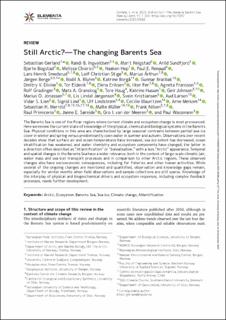| dc.contributor.author | Gerland, Sebastian | |
| dc.contributor.author | Ingvaldsen, Randi Brunvær | |
| dc.contributor.author | Reigstad, Marit | |
| dc.contributor.author | Sundfjord, Arild | |
| dc.contributor.author | Bogstad, Bjarte | |
| dc.contributor.author | Chierici, Melissa | |
| dc.contributor.author | Hop, Haakon | |
| dc.contributor.author | Renaud, Paul Eric | |
| dc.contributor.author | Smedsrud, Lars Henrik | |
| dc.contributor.author | Stige, Leif Christian | |
| dc.contributor.author | Årthun, Marius | |
| dc.contributor.author | Berge, Jørgen | |
| dc.contributor.author | Bluhm, Bodil Annikki Ulla Barbro | |
| dc.contributor.author | Borgå, Katrine | |
| dc.contributor.author | Bratbak, Gunnar | |
| dc.contributor.author | Divine, Dmitry V | |
| dc.contributor.author | Eldevik, Tor | |
| dc.contributor.author | Eriksen, Elena | |
| dc.contributor.author | Fer, Ilker | |
| dc.contributor.author | Fransson, Agneta | |
| dc.contributor.author | Gradinger, Rolf Rudolf | |
| dc.contributor.author | Granskog, Mats A. | |
| dc.contributor.author | Haug, Tore | |
| dc.contributor.author | Husum, Katrine | |
| dc.contributor.author | Johnsen, Geir | |
| dc.contributor.author | Jonassen, Marius Opsanger | |
| dc.contributor.author | Jørgensen, Lis Lindal | |
| dc.contributor.author | Kristiansen, Svein | |
| dc.contributor.author | Larsen, Aud | |
| dc.contributor.author | Lien, Vidar Surén | |
| dc.contributor.author | Lind, Sigrid | |
| dc.contributor.author | Lindstrøm, Ulf Ove | |
| dc.contributor.author | Mauritzen, Cecilie | |
| dc.contributor.author | Melsom, Arne | |
| dc.contributor.author | Mernild, Sebastian H. | |
| dc.contributor.author | Müller, Malte | |
| dc.contributor.author | Nilsen, Frank | |
| dc.contributor.author | Primicerio, Raul | |
| dc.contributor.author | Søreide, Janne | |
| dc.contributor.author | van der Meeren, Gro Ingleid | |
| dc.contributor.author | Wassmann, Paul | |
| dc.date.accessioned | 2023-11-27T13:25:19Z | |
| dc.date.available | 2023-11-27T13:25:19Z | |
| dc.date.created | 2023-11-22T09:51:59Z | |
| dc.date.issued | 2023 | |
| dc.identifier.citation | Elementa: Science of the Anthropocene. 2023, 11 . | |
| dc.identifier.issn | 2325-1026 | |
| dc.identifier.uri | https://hdl.handle.net/11250/3104818 | |
| dc.description.abstract | The Barents Sea is one of the Polar regions where current climate and ecosystem change is most pronounced. Here we review the current state of knowledge of the physical, chemical and biological systems in the Barents Sea. Physical conditions in this area are characterized by large seasonal contrasts between partial sea-ice cover in winter and spring versus predominantly open water in summer and autumn. Observations over recent decades show that surface air and ocean temperatures have increased, sea-ice extent has decreased, ocean stratification has weakened, and water chemistry and ecosystem components have changed, the latter in a direction often described as “Atlantification” or “borealisation,” with a less “Arctic” appearance. Temporal and spatial changes in the Barents Sea have a wider relevance, both in the context of large-scale climatic (air, water mass and sea-ice) transport processes and in comparison to other Arctic regions. These observed changes also have socioeconomic consequences, including for fisheries and other human activities. While several of the ongoing changes are monitored and quantified, observation and knowledge gaps remain, especially for winter months when field observations and sample collections are still sparse. Knowledge of the interplay of physical and biogeochemical drivers and ecosystem responses, including complex feedback processes, needs further development. | |
| dc.description.abstract | Still Arctic? — The changing Barents Sea | |
| dc.language.iso | eng | |
| dc.title | Still Arctic? — The changing Barents Sea | |
| dc.title.alternative | Still Arctic? — The changing Barents Sea | |
| dc.type | Peer reviewed | |
| dc.type | Journal article | |
| dc.description.version | publishedVersion | |
| dc.source.pagenumber | 62 | |
| dc.source.volume | 11 | |
| dc.source.journal | Elementa: Science of the Anthropocene | |
| dc.identifier.doi | 10.1525/elementa.2022.00088 | |
| dc.identifier.cristin | 2200051 | |
| dc.relation.project | Norges forskningsråd: 276730 | |
| dc.relation.project | Norges forskningsråd: 272721 | |
| cristin.ispublished | true | |
| cristin.fulltext | original | |
| cristin.qualitycode | 1 | |
